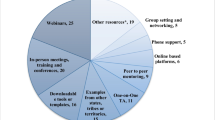Abstract
Deaf community members face many barriers to accessing health information. This paper discusses the feasibility of creating a nationwide network of Deaf-friendly ministries to help disseminate cancer information in American Sign Language (ASL) to the Deaf community. Deaf-friendly ministries (N = 403), identified through Internet searches and one-on-one referrals, were sent up to three mailed invitations to join the network. Over half of the ministries responded, with 191 (47.4 %) of the ministries joining the network, completing a baseline survey and receiving ASL cancer education videos to share with members of their congregation and community. Fifteen (3.7 %) responded that they were not interested or no longer had a Deaf-friendly ministry; the rest did not respond or their invitations were returned as undeliverable. As the program progressed, an additional 238 Deaf-friendly ministries were identified. To date, 61 (25.6 %) agreed to participate after the single invitation that was mailed. This network of Deaf-friendly ministries offers a promising dissemination partner.
Similar content being viewed by others
References
Barnett S (1999) Clinical and cultural issues in caring for deaf people. Fam Med 31(1):17–22
Barnett S, Franks P (2002) Health care utilization and adults who are deaf: relationship with age at onset of deafness. Health Serv Res 37(1):105–120
Choe S, Lim RS, Clark K, Wang R, Branz P, Sadler GR (2009) The impact of cervical cancer education for deaf women using a video educational tool employing American sign language, open captioning, and graphics. J Cancer Educ 24(1):10–15. doi:10.1080/08858190802665245
DeHaven MJ, Hunter IB, Wilder L, Walton JW, Berry J (2004) Health programs in faith-based organizations: are they effective? Am J Public Health 94(6):1030–1036
Disorders, National Institute on Deafness and Other Communication. 2012. Hearing Loss and Older Adults http://www.nidcd.nih.gov/health/hearing/pages/older.aspx Accessed
Dodani S, Kramer MK, Williams L, Crawford S, Kriska A (2009) Fit body and soul: a church-based behavioral lifestyle program for diabetes prevention in African Americans. Ethn Dis 19(2):135–141
Duan N, Fox SA, Derose KP, Carson S (2000) Maintaining mammography adherence through telephone counseling in a church-based trial. Am J Public Health 90(9):1468–1471
Folkins A, Sadler GR, Ko C, Branz P, Marsh S, Bovee M (2005) Improving the Deaf community's access to prostate and testicular cancer information: a survey study. BMC Publ Health 5:63. doi:10.1186/1471-2458-5-63
Harry KM, Malcarne VL, Branz P, Fager M, Garcia BD, Sadler GR (2012) Evaluating a skin cancer education program for the Deaf community. J Cancer Educ. doi:10.1007/s13187-012-0367-7
Heuttel KL, Rothstein WG (2001) HIV/AIDS knowledge and information sources among deaf and hearing college students. Am Ann Deaf 146(3):280–286
Hoang L, LaHousse SF, Nakaji MC, Sadler GR (2011) Assessing deaf cultural competency of physicians and medical students. J Cancer Educ 26(1):175–182. doi:10.1007/s13187-010-0144-4
Iezzoni LI, O'Day BL, Killeen M, Harker H (2004) Communicating about health care: observations from persons who are deaf or hard of hearing. Ann Intern Med 140(5):356–362
Meador HE, Zazove P (2005) Health care interactions with deaf culture. J Am Board Fam Pract 18(3):218–222
Mitchell RE, Karchmer MA (2004) Chasing the mythical Ten percent: parental hearing status of deaf and hard of hearing students in the United States. Sign Lang Stud 4(2):138–163
Tamaskar P, Malia T, Stern C, Gorenflo D, Meador H, Zazove P (2000) Preventive attitudes and beliefs of deaf and hard-of-hearing individuals. Arch Fam Med 9(6):518–25
Pollard RQ Jr, Barnett S (2009) Health-related vocabulary knowledge among deaf adults. Rehabil Psychol 54(2):182–185
Fox SA, Pitkin K, Paul C, Carson S, Duan N (1998) Breast cancer screening adherence: does church attendance matter? Health Educ Behav 25(6):742–758
Sadler GR, Sethee J, Tuzzio L, Sieben M, Ko CM, Christ HN (2001) Cancer education for clergy and lay church leaders. J Cancer Educ 16(3):146–149
Shabaik S, LaHousse SF, Branz P, Gandhi V, Khan AM, Sadler GR (2010) Colorectal cancer video for the deaf community: a randomized control trial. J Cancer Educ 25(4):518–523. doi:10.1007/s13187-010-0113-y
Thomas SB, Quinn SC, Billingsley A, Caldwell C (1994) The characteristics of northern black churches with community health outreach programs. Am J Public Health 84(4):575–579
Woodroffe T, Gorenflo DW, Meador HE, Zazove P (1998) Knowledge and attitudes about AIDS among deaf and hard of hearing persons. Aids Care 10(3):377–386
Yanek LR, Becker DM, Moy TF, Gittelsohn J, Koffman DM (2001) Project Joy: faith based cardiovascular health promotion for African American women. Public Health Rep 116(Suppl 1):68–81
Yao CS, Merz EL, Nakaji M, Harry KM, Malcarne VL, Sadler GR (2012) Cervical cancer control: deaf and hearing women's response to an educational video. J Cancer Educ 27(1):62–66. doi:10.1007/s13187-011-0264-5
Acknowledgments
This research was supported by the following grants: NIH 5P30CA023100; NIH U56CA92079/U56CA92081 and 1U54CA132379/1U54CA132384; NIH/NCMHD 5P60MD000220; NIH R25CA101317; NIH R25CA108731; UCSD Academic Senate Grant; The Susan G. Komen Breast Cancer Foundation, San Diego Affiliate Grant Award; Alliance Healthcare Foundation 99-99; and California Endowment. This project was created by an educational partnership consisting of: Moores UCSD Cancer Center, Deaf Community Services of San Diego Inc., Bovee Productions, the National Association of the Deaf, and Gallaudet University.
Author information
Authors and Affiliations
Corresponding author
Rights and permissions
About this article
Cite this article
Sadler, G.R., Branz, P., Fager, M. et al. Health Promotion via Deaf-Friendly Ministries. J Canc Educ 27, 606–611 (2012). https://doi.org/10.1007/s13187-012-0410-8
Published:
Issue Date:
DOI: https://doi.org/10.1007/s13187-012-0410-8




